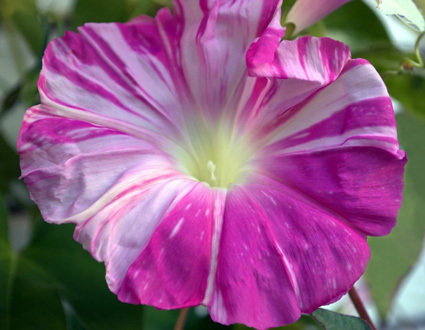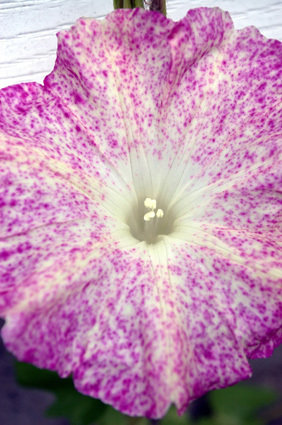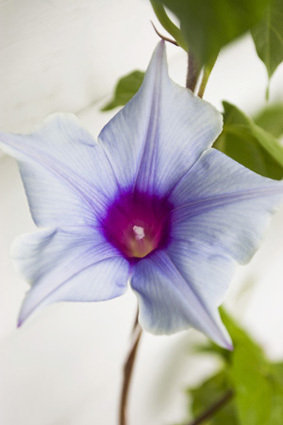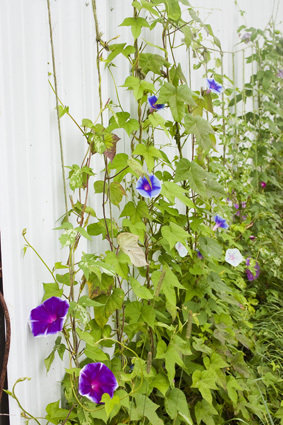





I use the term Japanese morning glory somewhat loosely to refer to exotic varieties, usually Ipomoea nil cultivars, as opposed to the more common Ipomoea purpurea types . The blooms of Japanese morning glories are usually larger, but produced--in my climate at least--in much lower numbers than what purpurea can manage. Fortunately, we gardeners tend to have a weakness for difficult plants!
 I don't, however, have the best growing conditions for Japanese morning glories. They prefer sandy soil. The long utility building against which I plant most of mine is sitting on almost pure clay.
I don't, however, have the best growing conditions for Japanese morning glories. They prefer sandy soil. The long utility building against which I plant most of mine is sitting on almost pure clay.
They also appreciate a long growing season. Here in Pennsylvania, I usually have to wait until late May to set them out. Since they tend to stall a bit during the hottest part of summer, by the time they begin blooming well in late August, the nights are already cooling. That combination of chilly temperatures and heavy dew on their large buds causes many of them to tear themselves apart as they try to open. So the flowers I do get are often ripped and tattered.
 I don't have a trellis for the morning glories either, so I improvise by recycling green baler twine, of which we have a lot here on the farm. I usually run one horizontal line the length of the building near the ground, and another about half way up. Then I tie vertical strings from one line to the other.
I don't have a trellis for the morning glories either, so I improvise by recycling green baler twine, of which we have a lot here on the farm. I usually run one horizontal line the length of the building near the ground, and another about half way up. Then I tie vertical strings from one line to the other.
I try to keep each morning glory on its own string, so I'll have some hope of identifying them if I want to save seeds. That, of course, doesn't last long, and they shortly become tangled with their neighbors. It's probably just as well, since they seldom have the time to set seeds here anyway.
So why do I bother with Japanese morning glories? Simply because there are few blooms more beautiful. They also give me something to look forward to in late summer when most other flowers are declining.
 If you want to grow your own, you'll probably need to trade for the seeds or purchase them on an online auction site, since few of the larger seed houses carry them. I frequently request Japanese morning glory seeds for Christmas, and am specific about which types I want. This ensures I'll get at least one gift that I like!
If you want to grow your own, you'll probably need to trade for the seeds or purchase them on an online auction site, since few of the larger seed houses carry them. I frequently request Japanese morning glory seeds for Christmas, and am specific about which types I want. This ensures I'll get at least one gift that I like!
Morning glory seeds remain viable for quite some time, so I plant old as well as new varieties every year. l pick out about 20 types to sow from the bag of packets that I've accumulated. Using little pudding or yogurt cups with the morning glories' names marked on the sides, I soak two seeds of each type overnight. Then I sow the seeds, which usually have started to crack open a bit, about 1/4 inch deep in six-cell planting packs of seed-sowing mix--three varieties per pack.
 They pop up quickly, within a couple days to a week or so. Sowing two of each type usually ensures that at least one will germinate--though not always! You may need to nick the hard or fuzzy coats on the seeds of species types of morning glories before soaking them, but the Japanese varieties seldom require that.
They pop up quickly, within a couple days to a week or so. Sowing two of each type usually ensures that at least one will germinate--though not always! You may need to nick the hard or fuzzy coats on the seeds of species types of morning glories before soaking them, but the Japanese varieties seldom require that.
When I transplant the seedlings into a long row on the east-facing wall of that building I mentioned, I usually sprinkle their leaves with cayenne pepper to discourage rabbits and groundhogs from chowing down on them. It's also a good idea to toss some slug bait around.
I don't fertilize morning glories, as I've heard horror stories about how that causes lots of leaves and few flowers. You might, however, be able to get away with using the bloom-booster type of fertilizer that is low in nitrogen. If any of you have tried that, please let me know how it worked for you.
Finally, don't forget to take a morning walk to look at the blooms. Many will close up by noon, though they do tend to stay open longer once the weather starts turning cooler. I can assure you that the shiver which runs through you when you sight them won't be entirely from the dew soaking your shoes!
The photos are all my own. The thumbnail is the Japanese morning glory Ukigumo.
Copyright © www.100flowers.win Botanic Garden All Rights Reserved